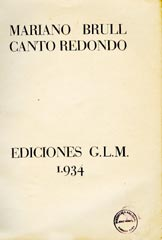4.1.1.7.2 The poetic work of Mariano Brull (1891 – 1956), from 1934

In 1934, Mariano Brull published “Canto redondo,” a work in which he displayed the most profound purism—redundancy intended—in his quest to access an ideal world by stripping away all the nuances of reality. In some verses, he continues to employ literary language purely phonically, which perhaps explains why he sometimes wrote directly in French without any chauvinistic qualms.
Regarding this collection of poems, Roberto Fernández Retamar stated: “Canto redondo is also a fortunate title because it indicates an exalted and perfect creation: it could be the title of Brull’s entire work, of his geometric canticle. The unity of this work, spanning more than twenty years, offers the surprise of a labor almost devoid of evolution, as if the objectivity that all pure poetry entails had erased the necessary life of the poet and its necessary alterations.”
In “Solo de rosa” (Only in pink), from 1941, Mariano Brull’s inquisitive attitude increases, his desire to unravel the essence of things sometimes involves creative twists and turns, in which the material rose must be metaphorically stripped of its leaves to reach beauty as an ideal, the perfect rose that constitutes the unattainable mold in which all real roses participate, an eminently Platonic thought, illustrated in “Epitaph to the rose”:
“I break a rose and I don’t find you.
In the wind, thus, leafless columns,
rose palace in ruins.
Now – impossible rose – you start:
by interwoven air needles
where all the roses
-before pink-
beauty are without prison of beauty.”
In 1950, he published “Tiempo en pena” (Time in Sorrow), which includes the poem cited in another section, “A toi – meme” (To Yourself). Unlike the initial enthusiasm with which he ventured into poetry, which he considered irrefutably pure as a sine qua non, these verses already reveal a certain anguish at the impossibility of penetrating the ideal realm of essences due to their very nonexistence. The inability to enjoy these poetic fruits then becomes a certain bitterness at the loss of meaning.
“Nothing More Than…”, from 1954, continues the author’s circumnavigations around a single poetic and the goal of reaching its elusive core, made only of sounds because words could not reflect the desired essences, in the realm of anomie. Perhaps here the poet had already reached the pinnacle of possibility, still far from his impossible ideal, and therefore had to fall silent, become nothing; silence and nothingness, symbols reiterated in Brull’s subsequent works.
Previously, in 1947, in “Orígenes,” he had published two poems entitled “Víspera” and “Última rosa.” The first of these pieces denotes a certain lyrical anguish derived from the chaos that constitutes his glimpsed fruitful paradise of essences, a refined tree of knowledge that cannot be accessed:
“I look into chaos…
Chaos and I
for not being one
we are not two.
Nobody’s life
You’re welcome… -No:
between two lives
living in two,
unique eve
double today.
Die in the mask
who looked at her
I -for two lives-
I die in two…








